A dedicated office could coordinate R&D efforts and focus on delivering prototypes of autonomous unmanned systems to the fleet.
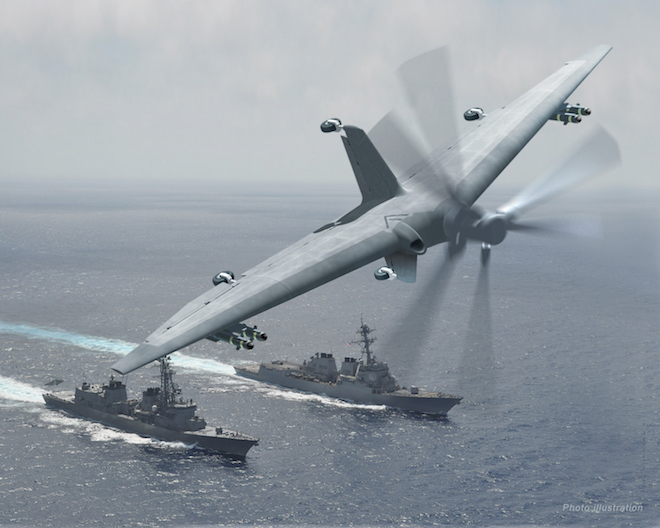
In recent years, the Navy has made notable progress in pursuing unmanned vehicles and their critical enabling technology, artificial intelligence (AI). To outpace potential adversaries, however, it must build on and accelerate those efforts. It must embark on a major reorganization similar to those that enabled it to develop naval nuclear reactors, submarine-launched ballistic missiles, and the Aegis weapon system.
In all three of those cases, the Navy created cross-functional, interdisciplinary organizations with personnel from the military, government civilian service, industry, and academia. These project offices were given the mandate and authority to research, develop, prototype, and operationalize transformational strategic capabilities. Establishing an Autonomy Project Office (APO) dedicated to delivering unmanned autonomous air, surface, and undersea vehicle prototypes would create unity of effort across the wide range of organizations, staffs, and commands within the research and development (R&D) constellation that have a role in this endeavor and would better harness the tremendous talent of U.S. engineers, scientists, and sailors. 1
Research Situation Today
The U.S. Navy has achieved some recent successes in autonomous unmanned system (UxS) strategy development, requests for proposals, and prototyping. In pursuit of system development, however, it still relies on a post–Cold War R&D structure optimized for an era when it did not face peer or near-peer threats. Although scientific and engineering talent remains strong, the constellation of UxS R&D organizations is not designed to coordinate diverse efforts and drive them toward definitive objectives. Through no fault of their own, these organizations’ activities often are disjointed, duplicative, and unaligned. What cross-organization collaboration that does exist often is driven by personal relationships among principal scientists/engineers as opposed to formal processes.
The slim advantage the United States currently enjoys over adversaries in AI and other key UxS supporting technologies will not be easy to sustain under the existing structure absent herculean effort and tremendous senior leader engagement. Specifically, the challenges to achieving UxS R&D success manifest in several ways.
Hyper-Focus | Starvation
Nine key UxS R&D expertise lines of effort (LOEs) are essential for the Navy’s development and prototyping of air, surface, and undersea UxSs: navigation control, mission autonomy, payloads, kinetics, human-machine teaming, communications, sensors, propulsion/energy endurance, and test and evaluation. An overall lack of collaboration and unity of effort across these lines has produced a “hyper-focus/starvation” environment for research priorities.
For example, the navigation control LOE (the development of programs/modules that can autonomously execute precision navigation using sensors and on-board inertial systems) is being researched at nearly two-thirds of the R&D organizations, often noncollaboratively. Conversely, the Navy is devoting the fewest resources to mission autonomy (the AI system to control the UxS) and UxS test and evaluation, even though both LOEs are critical to the future operational employment of UxS, are areas where the service has a clear deficit of knowledge and expertise, and require the largest effort to achieve progress.
Without a centralized, top-down prioritization to ensure a deliberate, purposeful assignment of R&D activities, research efforts and resources (time, people, and money) are at risk of being unstructured and inefficient.
Lack of Coherent Organizational Strategy
The Navy’s recently promulgated “Strategic Roadmap for Unmanned Systems” articulates the strategy and vision for research, development, and procurement of unmanned vehicles. 2 This document does not, however, go far enough in laying out a practical organizational framework to operationalize the strategy, achieve its goals, and transform the vision into concrete actions that deliver technological advancements. Missing is the comprehensive reorganization of the R&D bureaucracy needed to move the Navy onto an optimal track for success.
In an ideal organizational design, there is an operational middle tier that provides synchronization across the constellation. This tier is largely absent in the Navy’s R&D constellation, whose many components are widely dispersed throughout the Navy, resulting in overlapping authorities and ambiguity. The following are symptoms of this predicament:
Insufficient collaboration between fleet operators and the R&D constellation. There is a disconnect between what the R&D organizations believe they should develop and what the fleet says it requires to operate. Although they recognize the fleet as their primary customer, many UxS R&D organizations complain about insufficient access to operators, which manifests itself in a lack of understanding about fleet warfighting and operational capability requirements/concepts of operations.
On the operator side, fleet staffs and commands do not always recognize the value of active engagement with the constellation. They sometimes are unable to see the long-term strategic benefit of providing early input and guidance to shape the technological advancements needed to maintain maritime superiority.
Lack of awareness of centers of expertise within the R&D constellation . The research organizations often lack awareness of the core competencies or expertise resident in their peer organizations. This gap manifests in an inability to seek assistance from other R&D organizations when technical challenges stymie efforts to advance to the next phase in a project.
Bureaucratic, administrative, and risk-aversion impediments. UxS R&D efforts are hampered by bureaucratic and administrative barriers that often take the form of risk-management measures. Some measures are necessary for safety, financial, and other reasonable purposes, but there are a surprising number of policies and regulations that have created a risk aversion that stifles research and innovation and results in lost opportunities.
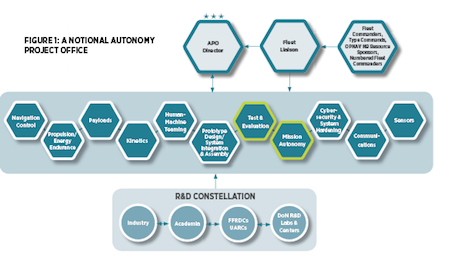
For example, there are high levels of frustration regarding unmanned aerial system testing, interpretations of Department of Defense Directive (DoDD) 3000.09, “Autonomy in Weapon Systems,” UxS lithium battery usage, and UxS interim authorization to test. This frustration was highlighted in the U.S. Naval Research Advisory Committee’s 2017 report:
[E]verywhere we did our fact-finding, people working on Navy unmanned/autonomous systems pointed to another factor they deemed even more consequential in slowing the movement of this new capability into the fleet—an unwillingness to take “bureaucratic risk.” Our research strongly suggests that the Department of the Navy and those private entities that regularly do business with it suffer from a pervasive culture of minimizing risk at the program management level at the expense of risk at the strategic level. . . . It is not an exaggeration to say that those who develop new warfighter technology felt that their attempts encountered debilitating bureaucratic barriers that strangled initiative and demoralized them. . . .
We have layers of accountability at the program manager level when they “overreach” and “fail,” but there is no accountability at the senior leader level when they fail to advance our capabilities fast enough to meet the strategic threat. 3
Researchers often chafed at policies, regulations, and measures that hobble their efforts but seemingly had no logic or common sense in their drafting and/or application. Others complained about tedious or overly bureaucratic review/approval processes that add substantial administrative burdens. The result is that innovative research halts while approval processes are negotiated.
Lack of a coherent plan to evaluate UxS R&D capability prototypes for transition and further development. Researchers report instances of science and technology prototypes that were developed to demonstrate future capabilities but subsequently were orphaned without being evaluated for use. To be clear, these are not situations in which a Navy entity assessed the prototype and decided that, although it was functional, it did not hold value for further exploration or transition into a future system. Instead, these systems were shelved without comprehensive evaluation. This issue sometimes is referred to as failing to cross the technology readiness level “Valley of Death.” 4
The transition problem is acute for UxS R&D because of the lack of integration in the overall development of those systems and vehicles. Technology development funding often is assigned to organizations within the R&D constellation in discrete, isolated streams, which means the prototype components produced typically are not tethered to existing UxS main projects or long-term capability requirements, preventing their holistic evaluation for continued development and use in future UxSs.
Inability to leverage emerging technologies nimbly. The Navy is unable to pivot the R&D constellation to exploit cutting-edge technologies emerging from industry and academia and evaluate them for further development and incorporation into future systems or prototypes. Although the Defense Advanced Research Projects Agency (DARPA) and Office of Naval Research have a history of successfully incentivizing and nurturing nascent technologies through their R&D funding programs, their missions and mandates do not necessarily provide the agility to collaborate with the innovators of new technology, evaluate its potential value to UxS prototyping, and surge resources and redirect focus among the constellation to continue advanced R&D.
Two recent breakthroughs in machine learning (an AI discipline used extensively in Silicon Valley driverless vehicle prototyping) exemplify its strong potential for future operational and warfighting capabilities: Google Deepmind’s AlphaGo and AlphaGo Zero systems—computer programs that play the ancient Chinese game of Go—and Carnegie Mellon University’s Libratus—an AI computer program designed to play Texas Hold ’Em poker. These are potent examples of boundary-breaking research and development that the Navy should task the UxS R&D constellation to pursue given their applicability to advanced war-fighting autonomy and AI systems.
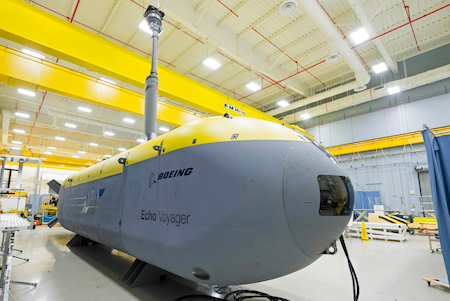
Echo Voyager is a fully autonomous extra large unmanned undersea vehicle that can be used for a variety of missions. (Boeing)
The Autonomy Project Office
To best deliver UxS, autonomy, and AI capabilities to the fleet, the Navy should apply the lessons from its past successes with nuclear reactors, submarine-launched ballistic missiles, and the Aegis weapon system and establish a cross-functional, interdisciplinary Autonomy Project Office. Its main mission should be to unify oversight, authority, and direction of all the R&D lines of effort to continuously spiral the latest technological advances into an assembly line of autonomous unmanned air, surface, and undersea vehicle prototypes that can be demonstrated for warfighting value and viability. 5
To synchronize diverse efforts and incentivize collaboration to more rapidly deliver UxS prototypes, the APO should include scientists, engineers, researchers, experts, and managers from all corners of the R&D constellation. Commensurate with its accountability and responsibility, the office must have authority to direct the constellation in all matters pertaining to UxS, autonomy, and AI R&D, prototyping, and test and evaluation, including funding assignment (but should not create its own duplicative R&D labs). The APO’s leaders and staff, however, must have a light touch—facilitating coordination without strangling innovation.
The APO should include the following 12 divisions: mission autonomy; navigation control; prototype design/systems integration and assembly; test and evaluation; fleet liaison; propulsion/energy endurance; communications; sensors; cybersecurity and system hardening; human-machine teaming; payloads; and kinetics. 6
The APO director should be an eight- to ten-year, billeted vice admiral position to ensure the director is vested with sufficient tenure and positional and rank authority to accomplish the organization’s demanding mission. This will allow the director to coordinate across critical three-star deputy Chief of Naval Operations positions, systems commanders, numbered fleet commanders, and type commanders.
For R&D organizations external to the Navy, the APO director should be given authority to issue contracts and other memoranda to employ these organizations in pursuing UxS R&D LOEs. For organizations within the Navy that do not fall under the APO’s direct administrative control, the APO should be vested with direct liaison authority and provisional/situational administrative control to support the efficient conduct of R&D, prototyping, and test and evaluation activities.
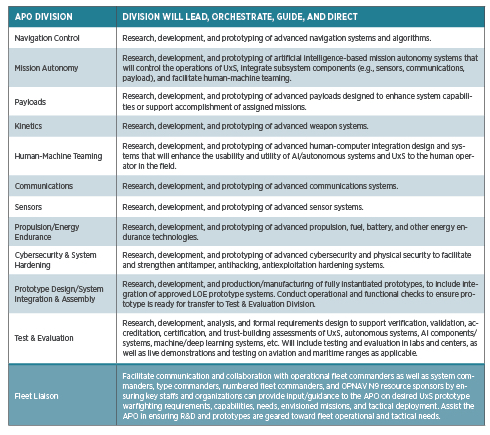
The APO director should have dual-reporting responsibility to both the Assistant Secretary of the Navy for Research, Development, and Acquisition and the Vice Chief of Naval Operations. Placing the APO as a direct report to the Vice Chief but external to the main Office of the Chief of Naval Operations (OPNAV) service staff and the naval systems commands will help insulate it from the bureaucratic, budgetary, and cultural turf fights that could detract from its primary mission. The four-star fleet commanders should have direct liaison authority to the APO director to ensure their operational capabilities/requirements requests can be addressed directly. Office of the Deputy Chief of Naval Operations for Warfare Systems (N9) resource sponsors also will require this authority to coordinate transitioning of proven prototypes into funded programs of record.
Similar to the director, Naval Reactors, an eight- to ten-year tenure would give the APO director the benefit of a long-duration, singular focus. Admirals Hyman Rickover and Wayne Meyer and naval aviation pioneer Admiral William Moffett benefited from long-term assignments, which allowed them to provide consistent and strategic leadership across their organizations. Ultimately, they articulated a vision for their organizations, inculcated it into the workforce, and implemented it successfully, delivering revolutionary and transformative capabilities.
The selection of the deputy directors who will be overseeing the LOEs also is vital, as it is within these divisions that the APO’s critical work will occur, namely, orchestration of R&D across the constellation. Deputy directors should be selected from among distinguished leaders in industry, academia, federally funded research and development centers/university-affiliated research centers, and Navy and Department of Defense labs who are recognized experts in the areas they would lead. Among their primary responsibilities would be to communicate with the organizations within their LOEs to leverage the latest technological advancements for the constellation to pursue.
The Advantages
Establishing an APO will accrue some definitive advantages to the Navy’s efforts to prototype and operationalize unmanned autonomous vehicles, including:
Providing well-defined authority and unity of direction. Creation of an APO would consolidate a multitude of dispersed, decentralized UxS efforts under a single organization that could provide unity of direction/effort, well-defined organizational command and control, and authority. This would clear out the current bureaucratic thickets and enhance the Navy’s ability to channel the innovation and energy of the UxS R&D constellation.
Institutionalizing UxS gains. Establishing the APO would allow the Secretary of the Navy and Chief of Naval Operations to affirm and make permanent the UxS, autonomy, and AI mandates they have imparted throughout the Navy. Without that permanence anchored by an APO, their vision could be nullified (through either benign or purposeful neglect) in the future.
Harnessing revolutionary technological breakthroughs. The APO could identify ground-breaking technologies, coordinate with the originating organizations to leverage their expertise, and then facilitate continued pursuit by the UxS R&D constellation. These breakthrough technologies then could be evaluated, shepherded, and nurtured for spiraling into future prototypes. In addition, the APO could help eliminate impediments to the successful transition of R&D technology that otherwise might not cross the “Valley of Death.”
Increasing the pace of experimentation and innovation. With an eye toward prudent safety and ethics, the APO could help pare down unnecessary or onerous policies/regulations to allow experimentation across all LOEs to progress more freely. Just as formalizing collaboration across the constellation will enhance technological advancement, so can the APO accelerate innovation and advancement by formalizing competitive experimentation. Within academia and the commercial sector, technological competitions of all varieties have accelerated the state of the art by unbridling the innovation and intelligence of the nation’s best and brightest scientists, engineers, students, and practitioners (for example, DARPA Driverless Vehicle Grand Challenges, DARPA Grand Cyber Challenge, and hackathons).
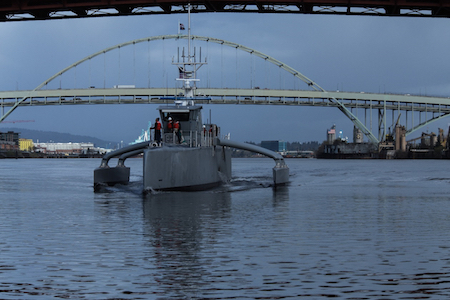
DARPA and the Office of Naval Research’s autonomous unmanned surface vehicle, Sea Hunter, under way for at-sea testing and operations. (U.S. Navy/Charles E. White)
Delivering on effective operationalization of UxS to the fleet. The proposed APO design includes a Fleet Liaison Division that would aid coordination and collaboration among the constellation during all phases of R&D, prototyping, test and evaluation, and operationalization. APO, N9 resource sponsors, and type and fleet commanders can ensure the Joint Capabilities Integration and Development System’s full Doctrine, Organization Training, Materiel, Leadership, Policy and Education, Personnel, Facilities and Policy (DOTMLPF-P) analysis is considered during every phase, ultimately streamlining the transition and operationalization of UxS to the fleet. 7
The U.S. Navy has achieved some UxS successes, but an Autonomy Project Office could help it better deliver on the promise of UxS and AI-based technology. Specifically, an APO could reduce the bureaucratic friction that is degrading the service’s ability to rapidly invent, innovate, and prototype, while accelerating progress across the existing UxS R&D constellation.
Author’s Note: For eight months, as a Navy Fellow at the Center for Strategic and Budgetary Assessments, the author led a comprehensive study of U.S. Navy R&D efforts focused on UxS and AI, which included numerous site visits and interviews with more than 160 subject-matter experts from 50+ federally funded research and development centers, university-affiliated research centers, industry partners, academic institutions, independent think tanks, DoD and DON labs/warfare centers, Navy fleet and operational commands, and Navy policy and research funding offices. This article is based on that research.
The Sidebar to this article by George Galdorisi and Scott Truver can be found here.
1. The “UxS R&D constellation” includes federally funded R&D centers, university affiliated research centers, industry, academia, and Department of Defense and Navy research labs and centers.
2. Department of the Navy, “ Department of the Navy Strategic Roadmap for Unmanned Systems ,” 2017.
3. U.S. Naval Research Advisory Committee, “ Autonomous and Unmanned Systems in the Department of the Navy ,” 2017.
4. “DOD has long noted the existence of a chasm between its science and technology community and its acquisition community that impedes technology transition from consistently occurring. This chasm, often referred to by department insiders as ‘the valley of death,’ exists because the acquisition community often requires a higher level of technology maturity than the science and technology community is willing to fund and develop.” Government Accountability Office, “Key Factors Drive Transition of Technologies, But Better Training and Data Dissemination Can Increase Success” (November 2015), 7.
5. The APO should develop hybrid semi-autonomous (human in the loop)/supervised-autonomous (human on the loop) UxS prototypes as defined in DoDD 3000.09.
6. More details can be found in the forthcoming monograph research report.
7. CJCS Instruction Number 3170.01I, Joint Capabilities Integration and Development System (23 January 2015).